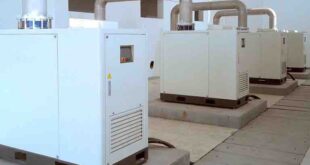Fusion is the reaction that powers the stars.
Energy is released when two small particles come together and fuse into one larger particle.
In experiments on Earth, these small particles are the nuclei of deuterium and tritium – types of heavy hydrogen – and they fuse together to make a helium nucleus. The waste product of fusion is helium, which is perfectly safe.
Fusion produces no greenhouse gases and no long-lived radioactive waste yet it produces vast amounts of energy from very little fuel.
The lithium from a laptop battery combined with the deuterium in half a bath of water could supply as much energy at 70 tonnes of coal.
As such it offers a clean, green and plentiful energy solution if it can be harnessed on Earth.
For fusion reactions to happen the deuterium and tritium must be very hot, so that the particles are moving so fast that if they collide they will overcome the mutual repulsion they feel for each other and get close enough to fuse.
At JET, the world’s largest operating tokamak (the specialised machines used for fusion), which once produced 16MW of fusion power, the fuel is heated to more than 100 million degrees – 7 times hotter than the centre of the Sun. Tokamak Energy, based just 5 miles away from JET, is now aiming to achieve this temperature in much smaller, cheaper tokamaks.
Magnetic fields are used to keep the superheated fuel (now an electrically charged gas called plasma) from touching the walls of its container and so keep it hot enough for fusion to occur. If the plasma does hit the wall it is not dangerous, it just cools down and everything stops.
Now Tokamak Energy has engaged engineering firm Adkins to help establish the costs, concept design and timeline for the first ever fusion facility to generate more energy than it consumes.
This is the first stage of a partnership that should evolve to deliver a fusion device to put energy into the grid.
The project will:
* Develop a timeline and strategy to secure the required authorisations and approvals for the facility. These include (where necessary) Development Consent Orders and Environmental Permits
* Develop a scheme design for the entire development, including designs for the reactor and all relevant infrastructure required to run it
* Develop a credible cost estimate, schedule and risk evaluation for the project, including design and construction of the facility as well as operations and decommissioning
The tokamak at the centre of this installation is expected to be about 3-4 times larger than Tokamak Energy’s current prototype device, the ST40, which is 4m tall and 2.5m in diameter.
If this project is successful, there will be scope to develop Tokamak Energy’s plans further with Atkins looking at how it can help support and enable the design of a fusion power plant ready for use in the energy network.
Tokamak Energy has already designed and built three experimental tokamak devices to prove the potential of its spherical compact design.
With the science behind the spherical compact design well-established, Atkins will use its considerable expertise to help tackle the regulatory and engineering challenges in bringing the technology to market in the future.
Tokamak Energy, through scientific research and engineering developments, makes use of novel superconducting materials to reduce the scale of a fusion reactor whilst still maintaining the power necessary for fusion. It is aiming to produce temperatures of 100 million degrees Celsius in its current prototype – the ST40 – in 2018. This is in the temperature range required to sustain a fusion reaction.
Atkins has more than 50 years of experience across the nuclear sector, including a multidisciplinary role on EDF Energy’s Hinkley Point C, as a founder of the Nuclear Safety Baseline and Design Authority and, since 2010, as Architect Engineer as part of the Engage consortium at the ITER fusion project in France.
This brings together scientific and engineering capabilities that ultimately aims to overcome the challenges of developing a commercial fusion power plant.
By tackling these engineering challenges, fusion energy can finally move from an industry viewed with scepticism to one with the potential to deliver our future energy needs, says Dr David Kingham, CEO of Tokamak Energy.
He says: “By working with one of the world’s most reputable engineering organisations, and one with an extensive history in nuclear development, we will turn the question over fusion energy from ‘if’ to ‘when’.
“The success of our compact spherical tokamaks and our theoretical work has established a clear route to fusion power, with an aim to get energy into the grid by 2030.
“With Atkins on board, we can now outline in detail how we will do this. Such speed and pace has been achieved before in UK engineering – Rolls Royce began development of a commercial jet engine in the 40s, with it gaining universal market acceptance in the 50s. Atkins allows us to match this vision and speed for fusion energy.”
Martin Grant, CEO of Atkins’ Energy business, said: “We are excited to be working with Tokamak Energy and we fully support their novel approach that seeks to make fusion power a cost effective and affordable reality.”
Atkins employs some 18,300 people across the UK, North America, Middle East, Asia Pacific and Europe
‘Tokamak’ is a Russian acronym that stands for toroidal chamber magnetic coils, which concisely describes the machine – a toroidal (doughnut-shaped) vessel with magnetic coils to trap and control the plasma. When they were introduced in the 1960s, tokamaks showed dramatically improved performance over the other methods being investigated. They heated and trapped the fuel much better than other approaches, such as pinches. Tokamaks were rapidly adopted by many international research teams and have remained the front runners in fusion research ever since
 Engineer News Network The ultimate online news and information resource for today’s engineer
Engineer News Network The ultimate online news and information resource for today’s engineer


